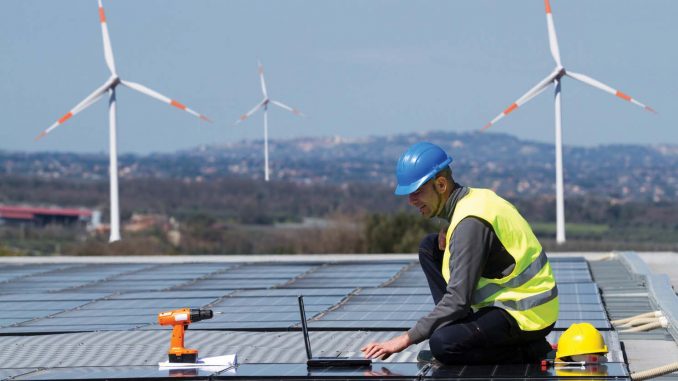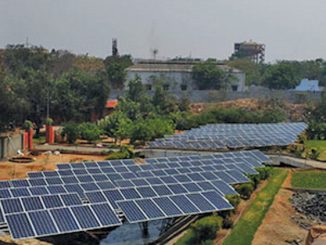
By Khushboo Goyal
To address the issues of demand-supply mismatch, energy security and climate change, the government, along with various state agencies, has been focusing on renewable energy development. However, land unavailability and transmission constraints make this a challenging task. In the past, many tenders have been postponed due to one or both of these limitations. In addition, solar and wind are intermittent energy sources, which makes it difficult to maintain the balance between power supply and demand at all times.
On the positive side, these two fastest growing renewable energy technologies have complementary generation patterns in the Indian context. While solar energy is present during the day (8 a.m. to 6 p.m.) and peaks around noon, wind energy is generated from late evening to early morning and peaks around night. This complementary pattern of wind and solar can be utilised by a solar-wind hybrid system to produce a somewhat constant source of energy throughout the day.
Benefits of solar-wind hybrids
Solar-wind hybrids are an excellent option to fully utilise land and energy resources. These plants can address the problem of intermittency associated with independent solar and wind energy resources to ensure a more reliable grid and balanced power supply. The peak power requirements can also be met to some extent with more balanced power generation and improved forecasting and scheduling. Deploying solar modules at high wind sites brings down the module temperature, leading to higher generation and lower degradation of solar modules.
Apart from providing reliable power supply, hybrids can optimise land use by co-locating wind and solar in the same land area. For instance, empty land tracts between wind turbines in a wind farm can be packed with solar panels. This can help generate more energy per unit area as compared to a stand-alone wind or solar plant. In a hybrid plant, the same land and infrastructure can be simultaneously used by both wind and solar. This includes access roads, boundaries and fencing, control centres, monitoring and communication channels, and firefighting equipment. Even the same power evacuation system can be used to feed both solar and wind power into the grid, owing to the complementary generation patterns of both the resources. While it is easier to set up a common evacuation system in a greenfield project, a brownfield project can also accommodate additional solar or wind capacity, provided it is less than the existing capacity.
In addition to these, a single team of technicians and service personnel can be trained to operate and maintain both the solar and wind plants. This can result in significant cost savings for a project developer. The landed cost of power for a solar-wind hybrid plant could be much lower than the combined cost of power from stand-alone solar and wind plants. Also, the entire infrastructure, particularly the evacuation system, is used more optimally as it is put to use throughout the day.
Potential and policy
The total potential of solar-wind hybrids in India is estimated at as high as 10,300 GW, as per the “Re-assessment of India’s On-shore Wind Power Potential” report jointly prepared by the Centre for Study of Science, Technology and Policy (CSTEP), WinDForce Management Services (WFMS) and Shakti Sustainable Energy Foundation (SSEF) in 2016. The report considers the total available land area to be 103,082 square km while the solar potential and hybrid-capable wind potential is estimated at 11,380 GW and 585 GW respectively. The solar potential has been calculated for areas with global horizontal irradiance of greater than 5.7 kWh per square metre, while the wind potential has been calculated for areas with wind speeds greater than 6 metres per second at 120 metre hub height.
Until recently, only small demonstration projects or pilot projects were being set up in the country. The lack of a proper policy or regulation for solar-wind hybrids prevented the large-scale uptake of these projects. The government has now realised the economic advantages of these projects. As a result, the Ministry of New and Renewable Energy (MNRE) released the National Wind-Solar Hybrid Policy in May 2018. The policy aims to provide a framework for the promotion of large grid-connected wind-solar hybrid systems for the optimal and efficient utilisation of transmission infrastructure and land in order to reduce the variability in renewable power generation and achieve better grid stability in the country.
Despite its large solar-wind hybrid potential, India’s first large-scale solar-wind hybrid plant was implemented only recently. This hybrid plant was commissioned by Hero Future Energies in April 2018 in Karnataka. The plant combines 50 MW of wind turbines with 29 MW of solar photovoltaic modules, and was set up by Siemens Gamesa. The plant operates in group captive mode and supplies power to industrial consumers at a competitive price.
The government’s recent policy initiative has led to the launch of a mega auction for solar-wind hybrid projects. The Solar Energy Corporation of India (SECI) has recently tendered 2,500 MW of interstate transmission system-connected wind-solar hybrid projects on a build-own-operate basis. The tariff ceiling has been fixed at Rs 2.93 per unit for the tender. SECI will sign power purchase agreements with the bidders for 25 years. The tender has a provision through which developers will be compensated for overgeneration to encourage bidders. Prior to this, SECI invited expressions of interest from engineering, procurement and construction contractors to develop a 160 MW solar-wind hybrid project with an energy storage system Ramagiri district of Andhra Pradesh.
Outlook
Solar-wind hybrid plant developers run into various technical and operational difficulties. This is because complex metering arrangements have to be undertaken to measure the generation of two resources instead of one. At times, developers have to curtail generation to maintain power evacuation at the defined capacity, resulting in losses. Co-located hybrid plants face issues such as high shading losses for solar panels owing to the shadow effect of wind turbines on solar generation. Another issue is the instability of solar structures located in high wind speed zones.
Despite several bottlenecks in their implementation, solar-wind hybrid projects are still commercially and technically viable. The integration of energy storage systems with hybrid plants is required to further improve the power curve and store surplus generation instead of curtailing it. Going forward, there is a clear need for proper metering and grid connectivity regulations and a tariff determination mechanism to remove the uncertainty associated with hybrid plants and promote their deployment.




